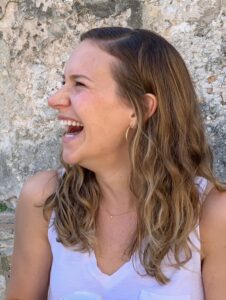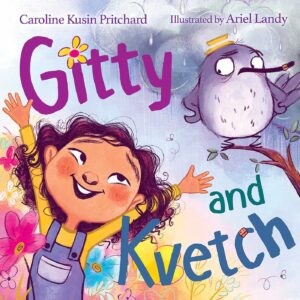Caroline Kusin Pritchard’s picture book, GITTY AND KVETCH (Atheneum, 2021) illustrated by Ariel Landy, is a charming story of an unlikely friendship between perky Gitty and her crusty bird friend, Kvetch. Packed with humor and heart, along with subtly layered emotional storylines, GITTY AND KVETCH is a perfect story to promote discussions about moods, attitudes, friendship, and acceptance. Yiddish words are cleverly peppered throughout, in a manner that allows contextual understanding. The illustrations are adorable and reflect the text beautifully.
I’m excited to chat with Caroline about the creation of this heartwarming picture book.
What inspired the relationship between cheerful Gitty and prickly Kvetch? Why is Kvetch a bird?
Kvetch can be a bit prickly, can’t he! The truth is that Gitty came to me first. I was teaching a summer school class on creative writing and took my students outside to brainstorm stories. I cracked open a new notebook and Gitty poured right out. I fell in love with this bundle of optimism who, against all odds, is just sure everything will work out perfectly. Right away I knew that she was planning a loving surprise for a friend… but who, and why? Maybe it’s because of the fleet of birds waddling across the grass to inspect our writing session, but soon enough the idea for Kvetch joined the party.
Kvetch was always the curmudgeonly yin to Gitty’s bubbly yang. But after what felt like hundreds of revisions, I knew something was still off. I shared a version with my wry, Kvetch-like older brother Eric. He’s the one who helped me realize that Kvetch wasn’t just a cautious grump for the sake of it… it was actually his way of protecting and loving Gitty! Shifting my approach to Kvetch as a loyal-to-the-core, practical realist helped endear me to his character and crack open the story.

How did using Yiddish expressions help in the creation of the story?
Growing up, I always adored the Yiddish that my family would liberally pepper into conversations. My grandpa wasn’t just proud of me… he was KVELLING. I wasn’t just bugging my dad with persistent questions… I was DRIVING HIM MESHUGGENEH! The language has always felt so expressive, so visceral. It feels personal! So much so that I even named our 120-lb dog “Mishpachah” (Misha for short).
Engaging with Yiddish makes me feel deeply connected to what I love about being Jewish—the passion, the resilience, the humor. I love that Kvetch is an intense, dynamic little bird who refuses to be pigeonholed (pun very much intended). His character organically mirrors the respect and love I have for the language, so incorporating Yiddish felt like a natural fit.
There are a lot of emotional layers in GITTY AND KVETCH, including an unexpected twist at the end. Can you share a bit about creating depth while keeping the story simple and accessible?
My mentor and one of my favorite children’s authors, Liz Garton Scanlon, shares the idea that emotional layers are about asking yourself the same question over and over: “What is the story about? Okay, now what is it really about?” I love this exercise, and it was instructive for me when writing this story. Yes, it’s about adventure. And of course it’s meant to make you laugh! But it’s also about apologies, about releasing perfectionism, about pushing beyond our own rigid comforts in the name of friendship… and hopefully lots more “abouts” that kids will discover for themselves!
The only way I knew how to layer in these ideas was through focusing on character. My job was to uncover the quirky voices and choices that were true to these best friends. And if I did my job well enough, if it became clear the lengths these two peculiar-but-lovable characters would go for one another, then hopefully the loftier themes would emerge on their own. For me, any other theme-centered approach risks becoming overly didactic and no longer centering kids.

What were your thoughts when you first saw Ariel Landy’s illustrations?
It felt like meeting Gitty and Kvetch for the first time! It’s exactly why I am so taken with the picture book form. What other medium allows two strangers to co-create a story independent of one another, not to mention a full ocean away? Ariel breathed life into these characters in a way that knocked the wind right out of me. The colors, worldbuilding, expressions… Kvetch’s HAT! Get out of here with that hat! I still cackle out loud every time I see the spread of Gitty falling progressively flatter on her face along with the line “ruined…ruined… RUINED!”
I feel forever indebted to my editor, Alexa Pastor, and the whole Atheneum team for pushing for Ariel’s creative brilliance from day one. What a gift and honor. And don’t get me started on those end pages! It was one of the first things my four-year-old clung to when reading the book: “Mama! That’s Gitty’s footprints and THAT’S Kvetch’s footprints!”
What do you hope young readers will come away with after reading GITTY AND KVETCH?
The big dream is that it might offer kids that magical jolt of connection that comes with reading a book that just *gets* you. Maybe that shows up as a belly laugh or a new idea they can’t wait to explore or simply a world that feels safe to curl up inside of for a while. And if a kid walks away with the idea that we all have a little Gitty and Kvetch inside of us, I may just do a bissel of kvelling myself.
I also firmly believe that representation matters across the board. Not just explicitly Jewish representation, like we so often see with picture books about holidays or food. But also casual, joyful representation. I hope that young readers delight in Kvetch’s Yiddish integrated throughout the text. I hope they spot and get curious about Gitty’s name spelled in Hebrew alongside a Magen David on her bedroom wall. I believe that incidental Jewish identity on the page has a role to play in countering harmful, even antisemitic, narratives. In its own small way, I hope that a story like Gitty and Kvetch can offer a joyful, humanizing counter-narrative for Jewish and non-Jewish kids alike.
Thank you, Caroline!
Caroline Kusin Pritchard grew up as the youngest of four children in Dallas, Texas, and spent her childhood sneaking extra helpings of noodle kugel from her bubbe’s kitchen. She has worked across the education field, everything from teaching brilliant third graders to helping develop federal policy. Caroline lives in the Bay Area with her husband, three kiddos, and their 120-pound dog. To learn more, visit carolinekusinpritchard.com. Twitter: @carolinepritch Instagram: @carolinepritchardwrites